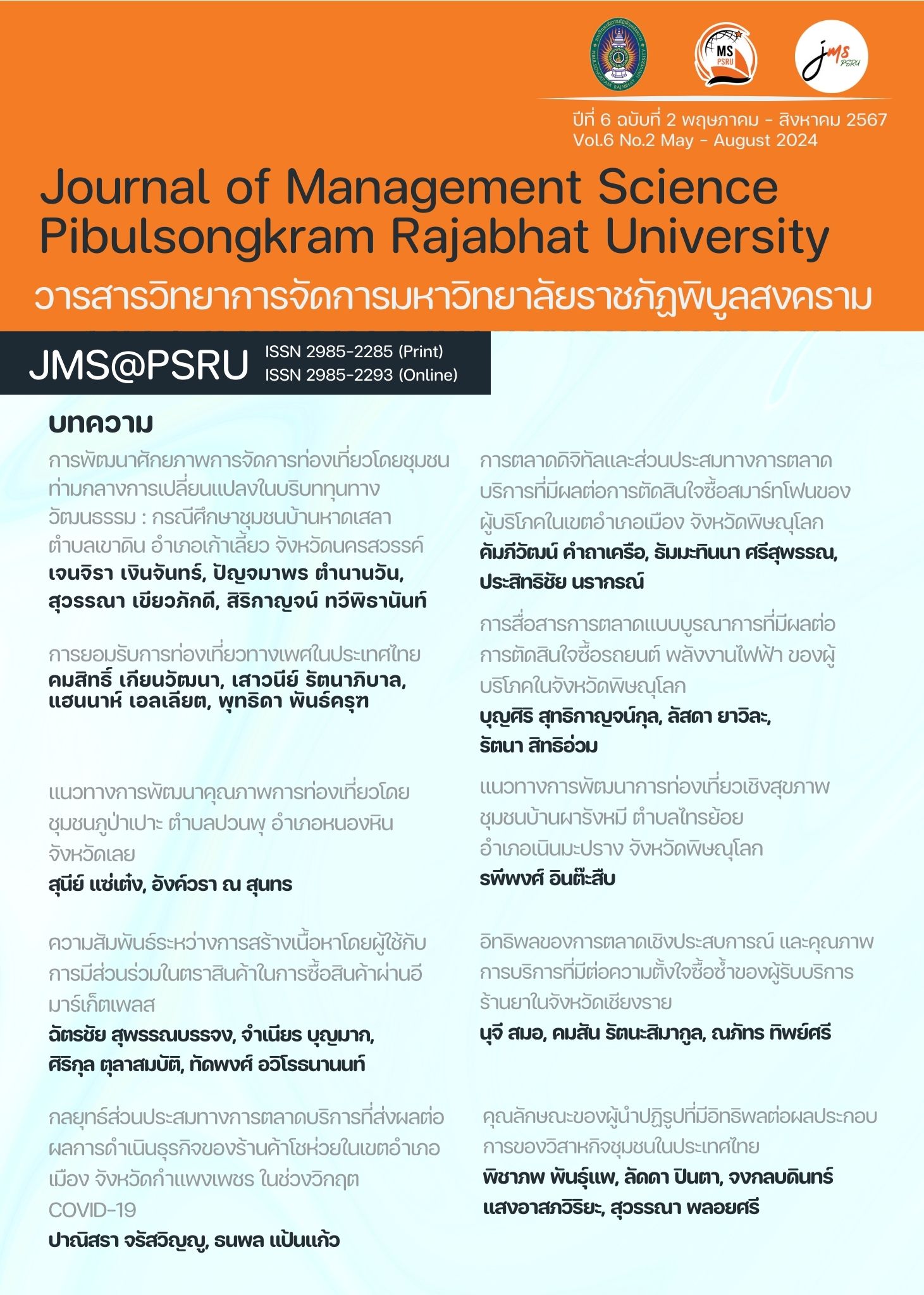Guidelines for Health Tourism Development of Ban Pha Rang Mee Community, Sai Yoi Subdistrict, Noen Maprang District Phitsanulok Province
Keywords:
Health Tourism, Ban Pha Rang Mee Community, Phitsanulok ProvinceAbstract
This mixed methods research aimed to study the tourism components and potential of tourism resources for develop health tourism of Ban Pha Rang Mee Community, Sai Yoi Subdistrict, Noen Maprang District, Phitsanulok Province, and investigate health tourism guidelines for the community’s health tourism. The data were collected by using a questionnaire, a semi-structured interview, an observation form, and an assessment form of tourism resource potential according to community tourism components. The data were analyzed by frequency, percentage, mean, standard deviation, and content analysis. The finding showed that there are 10 components of tourism in health tourism: value of tourist attractions, accessibility, tourism management system, amenities, carrying capacity, attraction environment, famous tourist attractions, activities, community’s participation, and supporting the development of quality of life and community economics. Also, it was found that the community’s potential of tourism resources was at a high level. In terms of the guidelines for organizing community health tourism, the value and potential of tourist attractions should be developed into attractions for health tourism in order to increase tourism options for communities and tourists; health tourism activities should be developed based on the value and potential of the area; community homestays should be developed to meet standards; and it should provide knowledge about health tourism to the community as well as develop and improve communication channels with tourists and those interested in general.
References
กระทรวงการท่องเที่ยวและกีฬา. (2559). รายงานภาวะเศรษฐกิจการท่องเที่ยว. สืบค้นเมื่อ 27 พฤศจิกายน 2566. จาก https://www.mots.go.th/news/category/397
ชาย โพธิสิตา. (2562). ศาสตร์และศิลป์การวิจัยเชิงคุณภาพ : คู่มือนักศึกษาและนักวิจัยสังคมศาสตร์ (พิมพ์ครั้งที่ 8). กรุงเทพฯ: อมรินทร์พริ้นติ้งแอนด์พับลิชชิ่ง.
ณัฐนนท์ จิรกิจนิมิต, ธนียา เจติยานุกรกุล และส่งเสริม แสงทอง. (2566). การพัฒนาหมู่บ้านต้นแบบการท่องเที่ยวเชิงสุขภาพในพื้นที่ดอยลังกา. วารสารสันติศึกษาปริทรรศน์ มจร, 11(1), 292-302.
เทอดศักดิ์ ศรีสุรพล. (2560). หลักการคู่มือการประเมินและกรณีตัวอย่างการประเมินศักยภาพแหล่งท่องเที่ยวชุมชน. กรุงเทพฯ: มหาวิทยาลัยราชภัฎสวนดุสิต.
นำขวัญ วงศ์ประทุม และดวงศิริ ภูมิวิชชุเวช. (2564). รูปแบบการจัดการการท่องเที่ยวเชิงสุขภาพโดยชุมชนตามศาสตร์พระราชา. วารสารศิลปะการจัดการ. 5(2), 299-311.
ประทีป พืชทองหลาง, พิมลพรรณ ปันทะเลิศ, ขิมมเรศ บริสุทธิ์ และกมลรส วรรณพรม. (2561). การจัดการแหล่ง ท่องเที่ยวเชิงสุขภาพของบ้านไร่กองขิง อำเภอหางดง จังหวัดเชียงใหม่. วารสารวิชาการ สถาบันการพลศึกษา, 10(3), 133-144.
พระครูรัตนสุตาภรณ์ (ธีรเดช โพธิ์ทอง) และพระราชรัตนสุธี (ขวัญรัก เกษรบัว). (2566). การพัฒนาชุดความรู้ภูมิปัญญาท้องถิ่นเพื่อส่งเสริมการท่องเที่ยวอำเภอเนินมะปราง จังหวัดพิษณุโลก. วารสารวิจัยวิชาการ, 6(3), 17-33.
เพชรศรี นนทร์ศิริ และชัยรัตน์ เชยสวรรค์. (2562). ศักยภาพทรัพยากรการท่องเที่ยวเชิงสุขภาพของกลุ่มจังหวัดภาคเหนือตอนล่าง 1 (ตาก สุโขทัย พิษณุโลก อุตรดิตถ์ เพชรบูรณ์). วารสารเทคโนโลยีภาคใต้, 13(1), 1-15.
ภคพร วัฒนดำรงค์. (2566). ความเป็นไปได้ในการบริหารจัดการส่งเสริมการท่องเที่ยวในจังหวัดพิษณุโลก.วารสารการจัดการธุรกิจ มหาวิทยาลัยบูรพา, 12(1), 51-69
รชพร จันทร์สว่าง, สุธิดา มณีอเนกคุณ, รสิกา อังกูร และทิพวัน ถือคำ. (2565). การท่องเที่ยวอาบป่า ความหมาย คุณค่า และประโยชน์ในบริบทของประเทศไทย. วารสารศิลปศาสตร์ปริทัศน์, 17(2), 80-96.
วรพรรณ จันทรากุลศิริ. (2562). การพัฒนารูปแบบการจัดกิจกรรมการท่องเที่ยวเชิงอายุวัฒนะในจังหวัดนครราชสีมา. วารสารมหาจุฬานาครทรรศน์, 6(3), 1304-1305.
วารีพร ชูศรี และ วรลักษณ์ ลลิตศศิวิมล. (2563). การท่องเที่ยวเชิงสุขภาพ: ความสามารถในการแข่งขันของประเทศไทย. วารสารมหาวิทยาลัยนราธิวาสราชนครินทร์ สาขามนุษยศาสตร์และสังคมศาสตร์, 7(2), 205-206.
สถาบันทรัพย์สินทางปัญญาแห่งจุฬาลงกรณ์มหาวิทยาลัย. (2560). รายงานการวิเคราะห์แนวโน้มเทคโนโลยีและอุตสาหกรรมการท่องเที่ยวกลุ่มรายได้ดีและการท่องเที่ยวเชิงสุขภาพ. สืบค้นเมื่อ วันที่ 26 ตุลาคม 2566, จาก https://www.ipthailand.go.th/images/3534/web_01052018/Report_CHU/8_Well-being_06.12.2017_CHU.pdf
สุนันทา คันธานนท์, อัครวัฒน์ จิตหาญ, กฤต เกษตรวัฒนผล, ขจร ทุ่มศร และ ชิดชัย กลิ่นประทุม. (2561). แนวทางการจัดการท่องเที่ยวเชิงสุขภาพ ชุมชนบ้านยวนสาว สายน้ำคลองพอถาก อำเภอเขาพนม จังหวัดกระบี่. ใน การประชุมวิชาการระดับชาติ มหาวิทยาลัยราชภัฏภูเก็ต ครั้งที่ 11 (น.37). ภูเก็ต: มหาวิทยาลัยราชภัฎภูเก็ต.
สุภางค์ จันทวานิช. (2557). วิธีการวิจัยเชิงคุณภาพ (พิมพ์ครั้งที่ 22). กรุงเทพฯ: สำนักพิมพ์แห่งจุฬาลงกรณ์มหาวิทยาลัย.
สำนักงานพัฒนาชุมชน จังหวัดพิษณุโลก. (2562). สรุปผลการดำเนินโครงการ“ชุมชนท่องเที่ยว OTOP นวัตวิถี จังหวัดพิษณุโลก”. สืบค้นเมื่อ 21 ตุลาคม 2565. จาก https://phitsanulok.cdd.go.th/wp-content/uploads/sites/38/2019/10/%E0%B8%AA%E0%B8%A3%E0%B8%B8%E0%B8%9B%E0%B8%99%E0%B8%A7%E0%B8%B1%E0%B8%95%E0%B8%A7%E0%B8%B4%E0%B8%96%E0%B8%B5.pdf
Anastasios R., (2017). Health, social and tourism policies: which synergies are possible ? Retrieved September 26, 2021, from https://slideplayer.com/slide/13496765/
Dunets, A. N., Yankovskaya, V., Plisova, A. B., Mikhailova, M. V., Vakhrushev, I. B., & Aleshko, R. A. (2020). Health tourism in low mountains: A case study. Entrepreneurship and Sustainability Issues, 7(3), 2213.
Holloway, J. C. (1998). The Business of Tourism (5th ed.). England: Longman.
Jyothis, T. (2016). Health Tourism: Pros and Cons. International Journal of Multidisciplinary Research and Modern Education. Retrieved September 26, 2021, from https://rdmodernresearch.org/wp-content/uploads/2016/06/224.pdf
Kiss, K. (2015). The challenges of developing health tourism in the Balkans. Tourism: An International Interdisciplinary Journal, 63(1), 97-110.
World Tourism Organization (UNWTO). (2022). Exploring Health Tourism Executive Summary. Retrieved October 26, 2022, from https://www.unwto.org/global/publication/exploring-health-tourism-executive-summary
Downloads
Published
How to Cite
Issue
Section
License
Copyright (c) 2024 Faculty of Management Science Pibulsongkram Rajabhat University

This work is licensed under a Creative Commons Attribution-NonCommercial-NoDerivatives 4.0 International License.
บทความที่ได้รับการตีพิมพ์ในวารสารวิทยาการจัดการมหาวิทยาลัยราชภัฏพิบูลสงคราม เป็นลิขสิทธิ์ของมหาวิทยาลัยราชภัฎพิบูลสงคราม
บทความที่ลงพิมพ์ใน วารสารวิทยาการจัดการมหาวิทยาลัยราชภัฎพิบูลสงคราม ถือว่าเป็นความเห็นส่วนตัวของผู้เขียนคณะบรรณาธิการไม่จำเป็นต้องเห็นด้วย ผู้เขียนต้องรับผิดชอบต่อบทความของตนเอง


